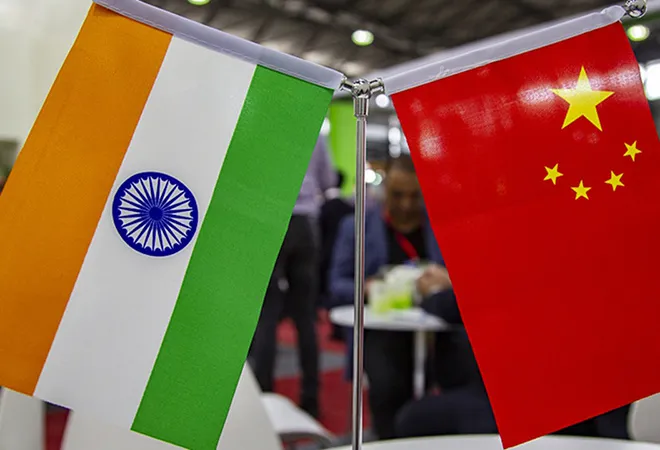
At a time when the Chinese leadership’s lack of interest in engaging the United States (US) is making headlines, China, in a striking contrast, has been carrying out back-to-back high-level exchanges with India in the past few days, amidst a continued stalemate at the Line of Actual Control (LAC). In early March, Chinese Foreign Minister Qin Gang visited India to attend the G20 foreign ministers’ meeting, where he held bilateral talks with Foreign Minister Dr. S Jaishankar on the border dispute. In late April, the Chinese and Indian militaries held the 18th round of the commander-level meeting. Soon after, Chinese State Councillor and Defense Minister Li Shangfu came to India on the occasion of the Shanghai Cooperation Organisation (SCO) Defense Ministers' Meeting, where he met his Indian counterpart, Rajnath Singh. Last week, Qin Gang once again came to India and held a dialogue with Dr S Jaishankar on the sidelines of the SCO Foreign Ministers' Meeting. It needs to be noted that the G20 and SCO meetings could have been attended virtually as
Pakistan’s defence minister did at the SCO Defense Ministers' Meeting, however, China chose otherwise. What could be the rationale behind China’s extensive India outreach of late?
Chinese State Councillor and Defense Minister Li Shangfu came to India on the occasion of the Shanghai Cooperation Organisation (SCO) Defense Ministers' Meeting, where he met his Indian counterpart, Rajnath Singh.
Discussions in the Chinese media and internet space indicate China’s keen interest, rather than urgency, to
ease or cool down the LAC situation and to break the
ice between China and India, and bring back
stability to China’s western frontier “as soon as possible”. This is so that it (China) can focus
whole-heartedly on the game with the US on the eastern frontier, as well as “clear up” the “Taiwan independence” forces.
Reacting to reports of growing India-US collaboration in the field of
high-technology,
defence,
and third-country cooperation among others, the voices of concern have been growing louder in China—that the more the China-India border row is dragged on, the more the hostility lingers, and greater the chances of the situation being exploited by powers hostile to China, causing the latter “great and unnecessary” troubles going forward. In this regard, China’s two biggest
concerns vis-á-vis India are: India’s possible choices in case of a Taiwan crisis; and India’s potential to replace China as a manufacturing power, given its demographic dividend, low cost, and large market. Not to mention, China also sees India as an
important overseas market, a critical factor for the smooth implementation of its Belt and Road Strategy as well as for de-dollarisation and
RMB internationalisation—since India is a member of both BRICS and SCO.
Some Chinese observers do admit that
India is the key to China’s future rise. Whether India will
play a positive or negative role will be an important factor in
determining the outcome of the US-China competition. Thus, Chinese strategists hope that if China-India relations can be normalised to a certain extent (for e.g., the
dialogue mechanism between the Chinese and Indian militaries or top leadership being strengthened, regular people-to-people exchange being restored, etc.) or at least an impression of it can be created at the international level, it will
slow down the progress of the US Indo-Pacific strategy and deliver a blow to the US interest in using India to
curtail China’s rise. No wonder all official and semi-official communications from China have been highlighting that the China-India border situation is “
generally stable”.
India’s possible choices in case of a Taiwan crisis; and India’s potential to replace China as a manufacturing power, given its demographic dividend, low cost, and large market.
However, for China, improving ties with India in actuality is easier said than done. Presently, the Chinese side seems to be smarting under what it calls India’s “
three conditions” to normalise China-India relations, as put forward by Defence Minister Rajnath Singh on 27 April 2023. These include: 1) Development of relations between India and China is premised on the prevalence of peace and tranquillity at the borders; 2) Differences at the LAC should be resolved in accordance with the existing agreements and obligations of the two countries; 3) If China wants to cool down the LAC situation, it needs to withdraw its troops and armaments from the border area. Sections within the Chinese strategic community has been fuming over, what they interpret as, India’s audacity to “
ask a price” from China to normalise ties, to dare to grab benefits from China, and pressurise China to make “
concessions” on the border issue. As per the Chinese assessment, the reason why India has maintained such a tough stance vis-á-vis China is because be it the US or Russia or China, under the current geopolitical situation, all major powers have been vying to get India on their side to further their respective national interest; India now has the “
bargaining power” to raise the price for cooperation with China.
Under such circumstances, on the one hand, voices are indeed getting louder in China urging the government not to give up
competitive military advantages vis-à-vis India at the LAC like in the Depsang Plains, to instead “teaching India a lesson”, “
building greater military advantage vis-á-vis India”, and “delivering a
thunderous blow to India like in 1962”, so that it does not dare to confront China on the Sino-Indian border issue in the next few decades. The latest voice being Chinese Foreign Minister Qin Gang, during his recent India trip, urging Minister Jaishankar to “take lessons from history”, which according to the Chinese assessment, is a warning to India to not forget the
lessons of the 1962 War. But on the other hand, there is also rising concern within Chinese strategic circles that any 1962-style military action against India will further deteriorate the situation, turning a country of India’s size, potential, and influence, into an entrenched enemy, which will not be
conducive to China’s development in the long run.
To address its ‘India dilemma’, China, in addition to directly communicating or negotiating with India through diplomatic and military channels, is also focusing on creating a “
stronger geopolitical environment” to resolve the China-India border crisis. As a part of this strategy, it is reportedly reaching out to India’s neighbours such as Pakistan, Myanmar, and other South Asian and Southeast Asian countries, urging them to provide “
assistance” to China in stabilising the situation on China’s western frontier, essentially by putting pressure on India from various directions, thereby forcing India to soften its stance towards China. The Bhutan PM’s
controversial interview, the back-to-back
China-Pakistan exchanges in recent months, and the Chinese FM’s recent
Myanmar visit—all are understood to be part of this strategy. The idea is to convey to India that China still hold some cards and does not need to give in to India’s demands to stabilise its western frontier.
There is also rising concern within Chinese strategic circles that any 1962-style military action against India will further deteriorate the situation, turning a country of India’s size, potential, and influence, into an entrenched enemy, which will not be conducive to China’s development in the long run.
Overall, there should be little room for confusion within the Indian strategic community about the mixed signals emanating from Beijing of late—where it is actively seeking to engage with Indian leaders and society at large, but doing little to change the situation at the LAC. Instead, soliciting help from India’s neighbours to create trouble for India, so that the pressure at China’s western frontier can be reduced—it is in this context that Indian
intelligence agencies have been lately highlighting China’s increased interest in fomenting unrest in the Northeast and other sensitive areas inside India. This is a part of China’s “two-handed preparations” vis-á-vis India—something that needs to be factored in appropriately during India’s future engagement with China.
Antara Ghosal Singh is a Fellow with the Strategic Studies Programme at the Observer Research Foundation
The views expressed above belong to the author(s). ORF research and analyses now available on Telegram! Click here to access our curated content — blogs, longforms and interviews.



 At a time when the Chinese leadership’s lack of interest in engaging the United States (US) is making headlines, China, in a striking contrast, has been carrying out back-to-back high-level exchanges with India in the past few days, amidst a continued stalemate at the Line of Actual Control (LAC). In early March, Chinese Foreign Minister Qin Gang visited India to attend the G20 foreign ministers’ meeting, where he held bilateral talks with Foreign Minister Dr. S Jaishankar on the border dispute. In late April, the Chinese and Indian militaries held the 18th round of the commander-level meeting. Soon after, Chinese State Councillor and Defense Minister Li Shangfu came to India on the occasion of the Shanghai Cooperation Organisation (SCO) Defense Ministers' Meeting, where he met his Indian counterpart, Rajnath Singh. Last week, Qin Gang once again came to India and held a dialogue with Dr S Jaishankar on the sidelines of the SCO Foreign Ministers' Meeting. It needs to be noted that the G20 and SCO meetings could have been attended virtually as
At a time when the Chinese leadership’s lack of interest in engaging the United States (US) is making headlines, China, in a striking contrast, has been carrying out back-to-back high-level exchanges with India in the past few days, amidst a continued stalemate at the Line of Actual Control (LAC). In early March, Chinese Foreign Minister Qin Gang visited India to attend the G20 foreign ministers’ meeting, where he held bilateral talks with Foreign Minister Dr. S Jaishankar on the border dispute. In late April, the Chinese and Indian militaries held the 18th round of the commander-level meeting. Soon after, Chinese State Councillor and Defense Minister Li Shangfu came to India on the occasion of the Shanghai Cooperation Organisation (SCO) Defense Ministers' Meeting, where he met his Indian counterpart, Rajnath Singh. Last week, Qin Gang once again came to India and held a dialogue with Dr S Jaishankar on the sidelines of the SCO Foreign Ministers' Meeting. It needs to be noted that the G20 and SCO meetings could have been attended virtually as  PREV
PREV


